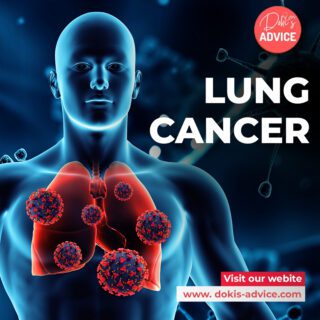Lung Cancer
 In Kenya, cancer is the 3rd leading cause of death, accounting for approximately 7% of the deaths per year, after infectious diseases and cardiovascular diseases.
In Kenya, cancer is the 3rd leading cause of death, accounting for approximately 7% of the deaths per year, after infectious diseases and cardiovascular diseases.
Generally, it’s difficult to get accurate data due to circumstances such as:
Low collection accuracy and underdiagnosis. A huge number of cancer patients could go undiagnosed, especially if they lack adequate funds for diagnostics and treatment, hence avoiding going to hospital.
Most of the data collected comes from Nairobi and other urbanised settings.
Most leading cancers in Kenya are:
- Breast cancer: 34 cases per 100,000 people
- Cervical cancer: 25 per 100,000 people
- Prostate cancer: 17 cases per 100,000 people
- Oesophageal cancer (food gut): 9 per 100,000 people
Approximately 75% of cancer cases are diagnosed in late stages due to factors named above as well as lack of awareness.
So, let’s dive into lung cancer as well as other types of cancers we will handle in coming articles.
Lung cancer is a malignant tumour growth that can occur in either side of the lungs or both. This can either be the main tumour or a metastasis (cancer spreading) of other types of cancers of the prostate, breast, head, neck, kidney, and womb, just to mention a few.
The downside of most cancers is that they have no initial symptoms that one could watch out for, in order to push one to go for an early check-up.
Nonetheless, lung cancer patients could experience common symptoms such as:
- Persistent dry coughing
- Coughing up blood
- Breathlessness or difficulties breathing.
- Unexplained loss of weight: particularly a huge amount of weight in within a short period of time
- Signs of anaemia: Loss of breath, getting tired quickly, pale face, heart palpitations
- Unexpected loss of appetite
- Pain while coughing or breathing.
- Problems swallowing
- Hoarseness of the voice
- Intermittent night fevers, sweating at night.
There are two main types of lung cancer:
- Non-small-cell lung cancer: this is the most common form, accounting for about 85% of most cases. It grows slowly before getting to the size in which it could start causing symptoms.
- Small-cell lung cancer accounts for about 15% or less of lungs cancers. It has a very fast growth rate hence could lead to quick deterioration of a patient’s symptoms due to early metastases (spreading).
The type of lung cancer a patient has determines the kind of therapy they will require.
The age at which most people are affected is around the age of 40 and above. Rarely does it occur to younger patients.
The most common cause of lung cancer, as we all know, is of course, smoking, which accounts for approximately 70% of the cases. This does not mean that nonsmokers cannot develop lung cancer.
Other causes of lung cancer among nonsmokers are:
- Long exposition to asbestos and radon exposure (a few studies have found high exposure to radon in the coastal region, especially in Taita/Taveta region and around Nairobi Kenyatta University).
- Exposure to Industrial gases and vehicle exhaust gases
- Exposure to polycyclic aromatic hydrocarbons: like cooking indoors with wood, there is a constant inhalation of the gases produced. This has also been seen to cause food-gut cancers.
- Exposure to some metals like: Arsen, chromium or Nickel
Let’s see how lung cancer can be diagnosed:
- X-Ray: though with this method, it’s rare to be able to see the tumours
- CT-Scan: This is the ideal method of diagnosis to determine the areas of metastasis, like the bone and brain.
- Getting a sample of the growth and sending it in for pathological testing to prove if its malignant or not.
- One can also do lab tests for markers in the blood.
– NSE: Mostly high in small-cell lung cancers
– LDH: generally, suspiciously high in most cancer patients, regardless of the type of cancer
– CYFRA-21: mostly determined to check therapy responsiveness.
Now that we know what methods we use to detect, lets dive into diff therapy regimes. These are also determined by how big the tumour is, how many of them are there, either on one side of the lung or both, and how far it has spread to other organs.
- Curative operative resection: This is mostly specific for small tumours that haven’t metastasized yet and are locally on one side of the lung and easily operatively reachable.
- Combination of operative resection and chemotherapy: This is also ideal for tumours that are relatively big but still operatively reachable for resection after going through chemotherapy with the intent to reduce the size of the tumour. Hence, this can also be done with an aim of curing.
- Combination of an operation, chemotherapy, and radiotherapy: This is done when the tumours are, for example, on both sides of the lungs and/or metastasized to the liver. One could either begin with chemotherapy to reduce the size of the tumours followed by an operative resection of the tumours or, in the end, do radiation therapy to ensure that all tumour masses that couldn’t be removed during the operation are also treated. Otherwise, one can do simultaneous chemotherapy and radiation therapy and at the end, do the operative resection.
- Palliative chemotherapy: this is does when the tumour isn’t operatively resectable and due to the presence of too many metastases. This means this can be done with the aim of just trying to shrink the tumour, to reduce the symptoms and not for the purpose of curing it.
- Radiation of the brain: This is done in cases of brain metastases with or without the option of an operation.
-Which therapy regime is appropriate for each patient is dependent on the stage of the cancer at the time of diagnosis, the patient’s capability to withstand a particular therapy regime, and their general health situation.
-Always seek medical advice from a professional oncologist, surgeon, and oncology-radiologist because the treatment of a lung cancer patient is a multidisciplinary therapy concept.
-Other than that, avoid smoking. If you are already a smoker, do your best to stop smoking or do smoking cessation therapy.
And as always, for more medical gems, keep it Doki’s Advice.

